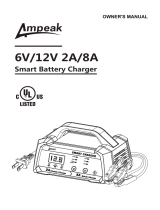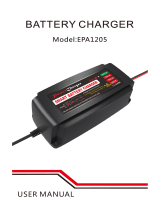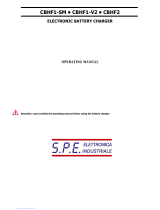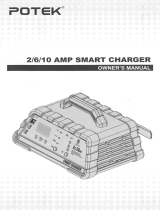
10 • US
Absorption (Lamp 3)
Final charging, voltage is kept at the preset level. During this phase, the voltage is gradu-
ally reduced. If the maximum length of time for Absorption is exceeded, the charger
automatically continues with Analysis. Absorption is indicated by lamp 3.
Analysis (Lamp 3)
Charging is suspended for a short period and the battery voltage measured. If it falls too
quickly, the battery is probably faulty. Charging is suspended and an error is indicated
(lamp 0).
0DLQWHQDQFHFKDUJLQJÁRDW/DPS
'XULQJWKH¿UVWGD\VRIPDLQWHQDQFHFKDUJLQJWKHEDWWHU\LVPDLQWDLQHGZLWKFRQVWDQW
voltage, 13.6V. Float-maintenance is indicated by lamp 4.
Maintenance charging - pulse (Lamp 4)
Thestateofchargevariesbetween 95%and100%.Thebatteryreceivesapulsewhen
thevoltagesinks,keepingthebatteryingoodshapewhenitisnotbeingused.Thechar-
ger can be connected for months at a time.
If the battery is charged and/or the battery’s terminal voltage drops, the charger starts a
charge pulse until the voltage has reached the preset level, 14.4V or 14.7V. The charge
pulseistheninterruptedandthecycleisrepeatedaslongasthechargerisinpulsemain-
tenance phase. If the terminal voltage drops even lower, the charger automatically reverts
to the beginning of the charging curve. Pulse maintenance phase is indicated by lamp 4. If
possible,checkthewaterlevelinthebattery.
Chosen mode: ”SUPPLY”
MULTIUS7002hasaSupplymodesettingwhichhasaconstantvoltageof13.6Vand
current up to 7A. This mode can also be used for maintenance charging of an already
fully charged battery, called Float maintenance. This type of charging keeps the battery
at 100% charge. The constant small overcharge can also increase water loss. A battery
doesnothavetobeconnectedforthechargertodelivervoltage.Thismeansthatthe
sparkprotectionisnotactiveinthismode.Itisnotappropriatetochargeacompletely
discharged battery in Supply mode, since this will not result in a completely charged
battery.Inthismode,MULTIUS7002canalsobeusedasapowergenerationunitfor
operatingequipmentthatrequires13.6Vandamaximumof7A.Iftheselectedcurrent
exceeds7A,theoutputvoltagewilldropastheloadincreases.Thechargerhaselectronic
overload protection in this mode, which is activated if the charge is so great that the output
voltagefromthechargerfallsbelowaround 9Vandthecurrentísaround7A.Intheevent
of an overload, the charger goes into error mode (lamp 0). Supply mode is indicated with
lamp D and lamp 5.


















